Business Decision Making Report: Evaluating Decision Making Systems
VerifiedAdded on 2020/10/04
|13
|3694
|460
Report
AI Summary
This report delves into the intricacies of business decision-making through a detailed analysis of a redundancy case study. It begins with problem definition, identifying the organizational challenges stemming from governmental policy changes impacting product profitability. A situational analysis, employing SWOT analysis, assesses the company's strengths, weaknesses, opportunities, and threats. The report then explores the sense-making process, offering insights into understanding the situation and envisioning solutions. Potential solutions, including workforce reduction strategies, are formulated and evaluated. The core of the report focuses on selecting the optimal solution, considering factors like freezing recruitment and reducing working weeks. The decision-making process is explained, alongside implementation strategies, testing, and team feedback. Finally, the report concludes with recommendations to enhance productivity and profitability. The report aims to provide a comprehensive guide to effective business decision-making under challenging circumstances.

Business Decision Making
1
1
Paraphrase This Document
Need a fresh take? Get an instant paraphrase of this document with our AI Paraphraser
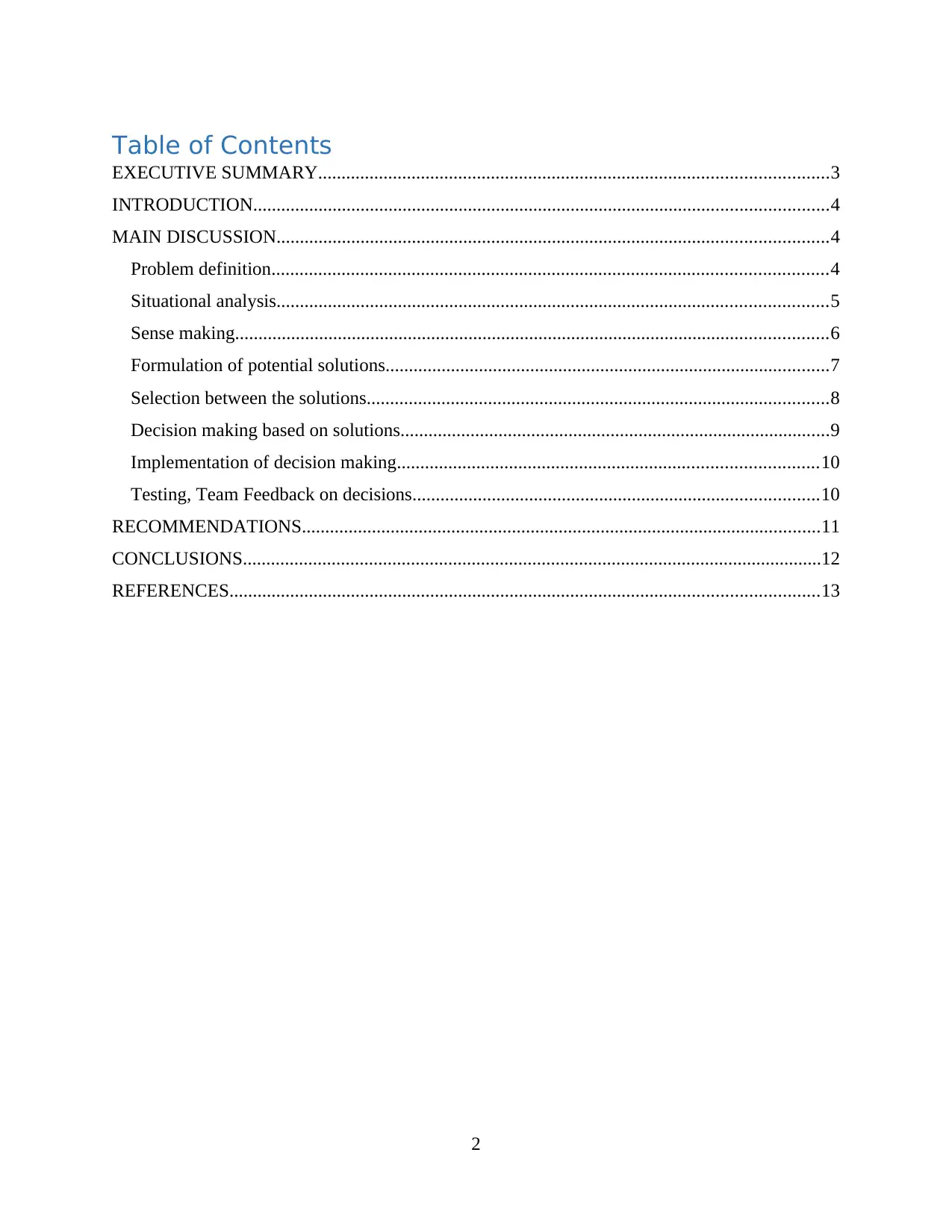
Table of Contents
EXECUTIVE SUMMARY.............................................................................................................3
INTRODUCTION...........................................................................................................................4
MAIN DISCUSSION......................................................................................................................4
Problem definition.......................................................................................................................4
Situational analysis......................................................................................................................5
Sense making...............................................................................................................................6
Formulation of potential solutions...............................................................................................7
Selection between the solutions...................................................................................................8
Decision making based on solutions............................................................................................9
Implementation of decision making..........................................................................................10
Testing, Team Feedback on decisions.......................................................................................10
RECOMMENDATIONS...............................................................................................................11
CONCLUSIONS............................................................................................................................12
REFERENCES..............................................................................................................................13
2
EXECUTIVE SUMMARY.............................................................................................................3
INTRODUCTION...........................................................................................................................4
MAIN DISCUSSION......................................................................................................................4
Problem definition.......................................................................................................................4
Situational analysis......................................................................................................................5
Sense making...............................................................................................................................6
Formulation of potential solutions...............................................................................................7
Selection between the solutions...................................................................................................8
Decision making based on solutions............................................................................................9
Implementation of decision making..........................................................................................10
Testing, Team Feedback on decisions.......................................................................................10
RECOMMENDATIONS...............................................................................................................11
CONCLUSIONS............................................................................................................................12
REFERENCES..............................................................................................................................13
2

EXECUTIVE SUMMARY
This report summarises business decision process by evaluating decision making system
and techniques. A group exercise in terms of managing the business decisions in critical
changing circumstances of business are analysed with critical explanation. Tools and techniques
for better decision making process also summarised in this report.
3
This report summarises business decision process by evaluating decision making system
and techniques. A group exercise in terms of managing the business decisions in critical
changing circumstances of business are analysed with critical explanation. Tools and techniques
for better decision making process also summarised in this report.
3
⊘ This is a preview!⊘
Do you want full access?
Subscribe today to unlock all pages.

Trusted by 1+ million students worldwide
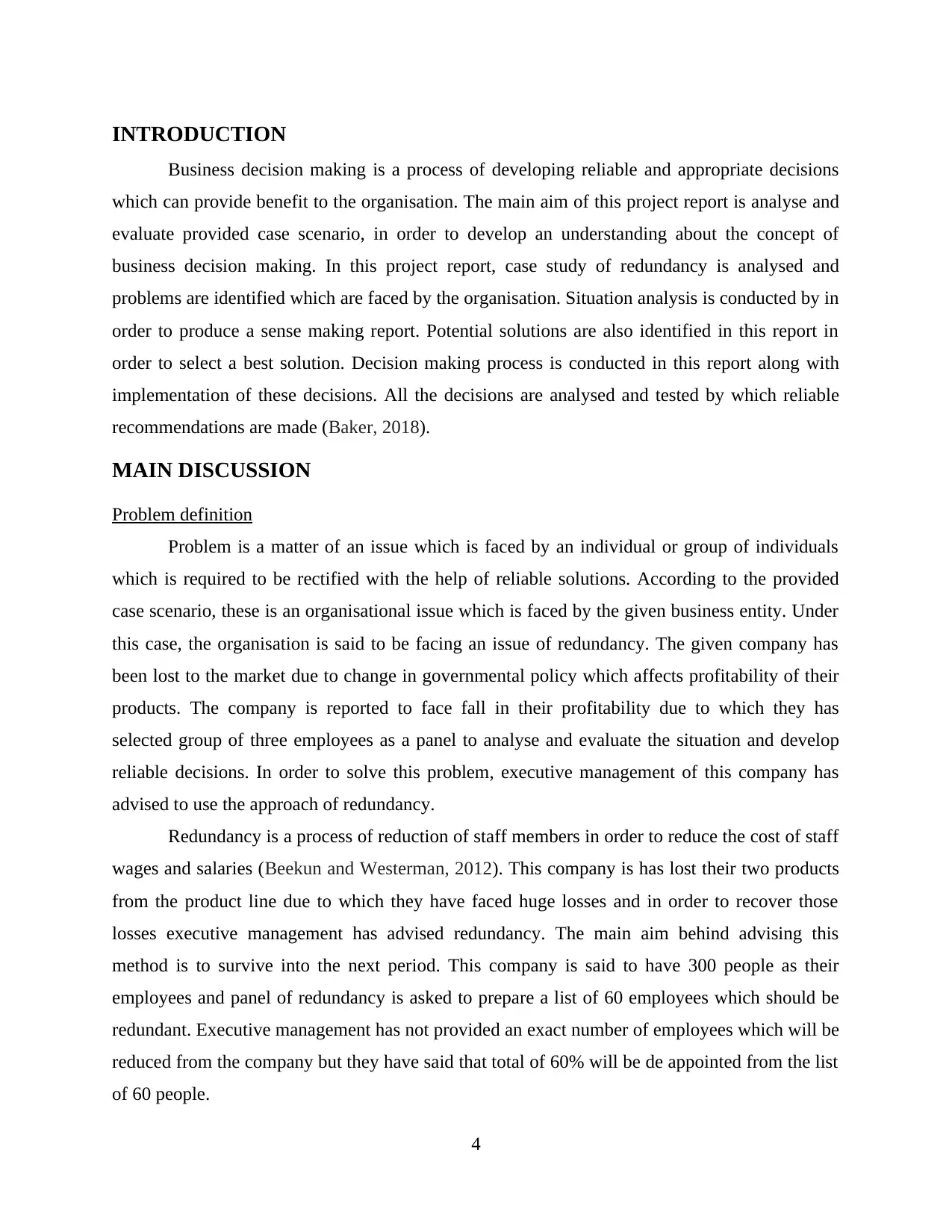
INTRODUCTION
Business decision making is a process of developing reliable and appropriate decisions
which can provide benefit to the organisation. The main aim of this project report is analyse and
evaluate provided case scenario, in order to develop an understanding about the concept of
business decision making. In this project report, case study of redundancy is analysed and
problems are identified which are faced by the organisation. Situation analysis is conducted by in
order to produce a sense making report. Potential solutions are also identified in this report in
order to select a best solution. Decision making process is conducted in this report along with
implementation of these decisions. All the decisions are analysed and tested by which reliable
recommendations are made (Baker, 2018).
MAIN DISCUSSION
Problem definition
Problem is a matter of an issue which is faced by an individual or group of individuals
which is required to be rectified with the help of reliable solutions. According to the provided
case scenario, these is an organisational issue which is faced by the given business entity. Under
this case, the organisation is said to be facing an issue of redundancy. The given company has
been lost to the market due to change in governmental policy which affects profitability of their
products. The company is reported to face fall in their profitability due to which they has
selected group of three employees as a panel to analyse and evaluate the situation and develop
reliable decisions. In order to solve this problem, executive management of this company has
advised to use the approach of redundancy.
Redundancy is a process of reduction of staff members in order to reduce the cost of staff
wages and salaries (Beekun and Westerman, 2012). This company is has lost their two products
from the product line due to which they have faced huge losses and in order to recover those
losses executive management has advised redundancy. The main aim behind advising this
method is to survive into the next period. This company is said to have 300 people as their
employees and panel of redundancy is asked to prepare a list of 60 employees which should be
redundant. Executive management has not provided an exact number of employees which will be
reduced from the company but they have said that total of 60% will be de appointed from the list
of 60 people.
4
Business decision making is a process of developing reliable and appropriate decisions
which can provide benefit to the organisation. The main aim of this project report is analyse and
evaluate provided case scenario, in order to develop an understanding about the concept of
business decision making. In this project report, case study of redundancy is analysed and
problems are identified which are faced by the organisation. Situation analysis is conducted by in
order to produce a sense making report. Potential solutions are also identified in this report in
order to select a best solution. Decision making process is conducted in this report along with
implementation of these decisions. All the decisions are analysed and tested by which reliable
recommendations are made (Baker, 2018).
MAIN DISCUSSION
Problem definition
Problem is a matter of an issue which is faced by an individual or group of individuals
which is required to be rectified with the help of reliable solutions. According to the provided
case scenario, these is an organisational issue which is faced by the given business entity. Under
this case, the organisation is said to be facing an issue of redundancy. The given company has
been lost to the market due to change in governmental policy which affects profitability of their
products. The company is reported to face fall in their profitability due to which they has
selected group of three employees as a panel to analyse and evaluate the situation and develop
reliable decisions. In order to solve this problem, executive management of this company has
advised to use the approach of redundancy.
Redundancy is a process of reduction of staff members in order to reduce the cost of staff
wages and salaries (Beekun and Westerman, 2012). This company is has lost their two products
from the product line due to which they have faced huge losses and in order to recover those
losses executive management has advised redundancy. The main aim behind advising this
method is to survive into the next period. This company is said to have 300 people as their
employees and panel of redundancy is asked to prepare a list of 60 employees which should be
redundant. Executive management has not provided an exact number of employees which will be
reduced from the company but they have said that total of 60% will be de appointed from the list
of 60 people.
4
Paraphrase This Document
Need a fresh take? Get an instant paraphrase of this document with our AI Paraphraser
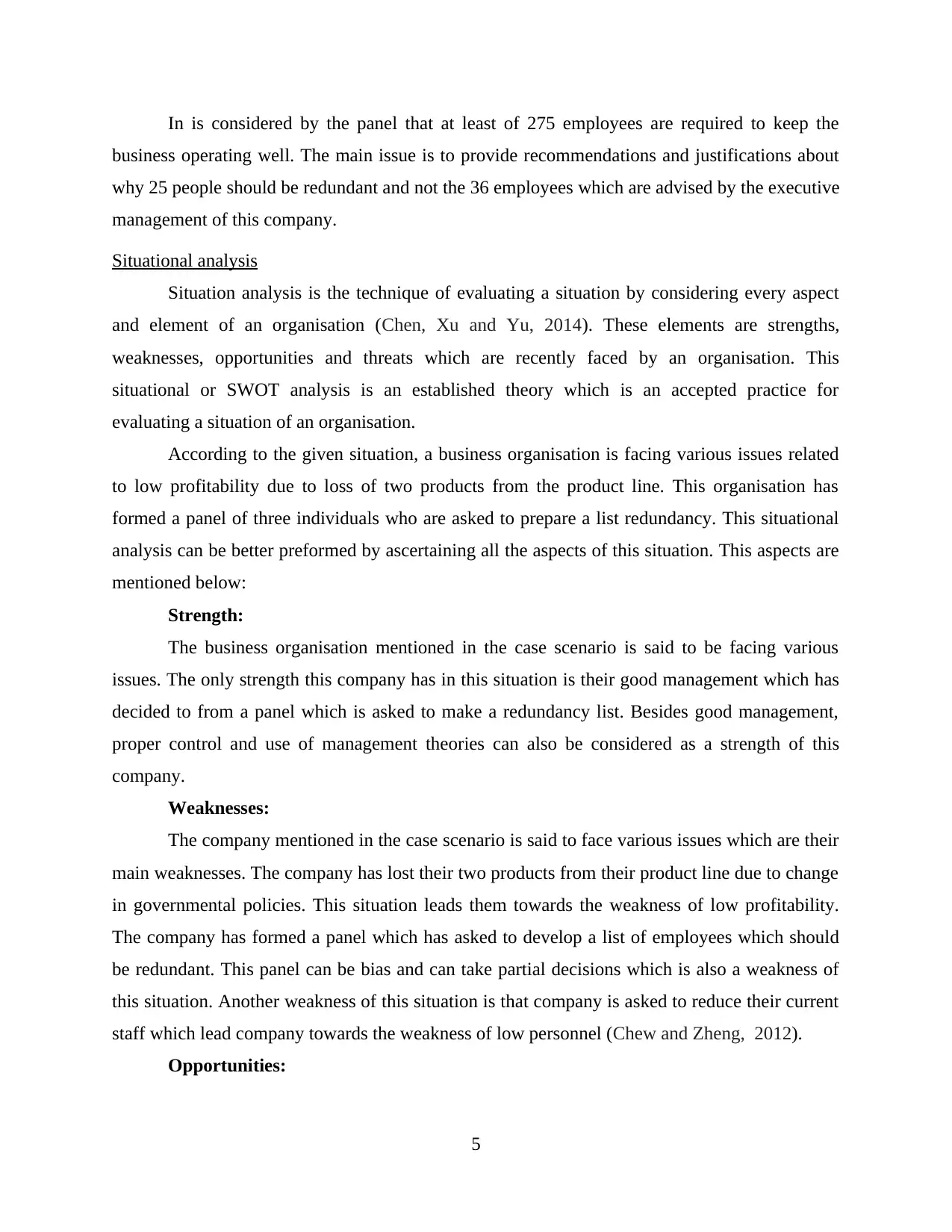
In is considered by the panel that at least of 275 employees are required to keep the
business operating well. The main issue is to provide recommendations and justifications about
why 25 people should be redundant and not the 36 employees which are advised by the executive
management of this company.
Situational analysis
Situation analysis is the technique of evaluating a situation by considering every aspect
and element of an organisation (Chen, Xu and Yu, 2014). These elements are strengths,
weaknesses, opportunities and threats which are recently faced by an organisation. This
situational or SWOT analysis is an established theory which is an accepted practice for
evaluating a situation of an organisation.
According to the given situation, a business organisation is facing various issues related
to low profitability due to loss of two products from the product line. This organisation has
formed a panel of three individuals who are asked to prepare a list redundancy. This situational
analysis can be better preformed by ascertaining all the aspects of this situation. This aspects are
mentioned below:
Strength:
The business organisation mentioned in the case scenario is said to be facing various
issues. The only strength this company has in this situation is their good management which has
decided to from a panel which is asked to make a redundancy list. Besides good management,
proper control and use of management theories can also be considered as a strength of this
company.
Weaknesses:
The company mentioned in the case scenario is said to face various issues which are their
main weaknesses. The company has lost their two products from their product line due to change
in governmental policies. This situation leads them towards the weakness of low profitability.
The company has formed a panel which has asked to develop a list of employees which should
be redundant. This panel can be bias and can take partial decisions which is also a weakness of
this situation. Another weakness of this situation is that company is asked to reduce their current
staff which lead company towards the weakness of low personnel (Chew and Zheng, 2012).
Opportunities:
5
business operating well. The main issue is to provide recommendations and justifications about
why 25 people should be redundant and not the 36 employees which are advised by the executive
management of this company.
Situational analysis
Situation analysis is the technique of evaluating a situation by considering every aspect
and element of an organisation (Chen, Xu and Yu, 2014). These elements are strengths,
weaknesses, opportunities and threats which are recently faced by an organisation. This
situational or SWOT analysis is an established theory which is an accepted practice for
evaluating a situation of an organisation.
According to the given situation, a business organisation is facing various issues related
to low profitability due to loss of two products from the product line. This organisation has
formed a panel of three individuals who are asked to prepare a list redundancy. This situational
analysis can be better preformed by ascertaining all the aspects of this situation. This aspects are
mentioned below:
Strength:
The business organisation mentioned in the case scenario is said to be facing various
issues. The only strength this company has in this situation is their good management which has
decided to from a panel which is asked to make a redundancy list. Besides good management,
proper control and use of management theories can also be considered as a strength of this
company.
Weaknesses:
The company mentioned in the case scenario is said to face various issues which are their
main weaknesses. The company has lost their two products from their product line due to change
in governmental policies. This situation leads them towards the weakness of low profitability.
The company has formed a panel which has asked to develop a list of employees which should
be redundant. This panel can be bias and can take partial decisions which is also a weakness of
this situation. Another weakness of this situation is that company is asked to reduce their current
staff which lead company towards the weakness of low personnel (Chew and Zheng, 2012).
Opportunities:
5
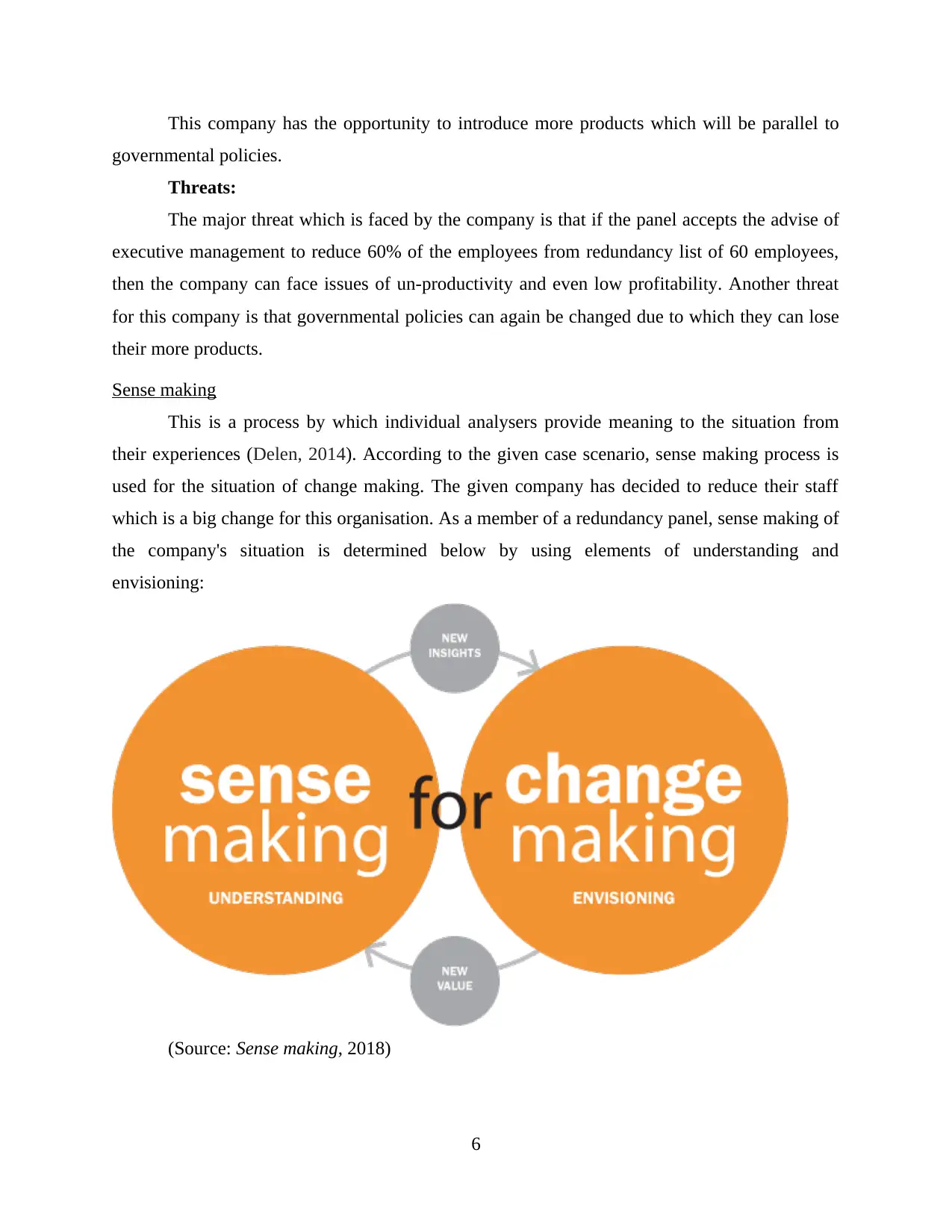
This company has the opportunity to introduce more products which will be parallel to
governmental policies.
Threats:
The major threat which is faced by the company is that if the panel accepts the advise of
executive management to reduce 60% of the employees from redundancy list of 60 employees,
then the company can face issues of un-productivity and even low profitability. Another threat
for this company is that governmental policies can again be changed due to which they can lose
their more products.
Sense making
This is a process by which individual analysers provide meaning to the situation from
their experiences (Delen, 2014). According to the given case scenario, sense making process is
used for the situation of change making. The given company has decided to reduce their staff
which is a big change for this organisation. As a member of a redundancy panel, sense making of
the company's situation is determined below by using elements of understanding and
envisioning:
(Source: Sense making, 2018)
6
governmental policies.
Threats:
The major threat which is faced by the company is that if the panel accepts the advise of
executive management to reduce 60% of the employees from redundancy list of 60 employees,
then the company can face issues of un-productivity and even low profitability. Another threat
for this company is that governmental policies can again be changed due to which they can lose
their more products.
Sense making
This is a process by which individual analysers provide meaning to the situation from
their experiences (Delen, 2014). According to the given case scenario, sense making process is
used for the situation of change making. The given company has decided to reduce their staff
which is a big change for this organisation. As a member of a redundancy panel, sense making of
the company's situation is determined below by using elements of understanding and
envisioning:
(Source: Sense making, 2018)
6
⊘ This is a preview!⊘
Do you want full access?
Subscribe today to unlock all pages.

Trusted by 1+ million students worldwide

Understanding – It is important to understand the situation of the given business
organisation effectively in order to provide new insights. From the case scenario, as a panel
member it has been understood due to loss of two products from the product line company is
facing various losses. In order to rectify this situation, it is important to reduce the number of
employees. It is considered that at least 275 people are required to operate this company
effectively. New insights should be provide to executive management about only 25 employees
should be deployed from the organisation and not 36 employees which is advised by the
management.
Envisioning – After understanding the situation, a new vision is provided to the
executive management with new values. This management must be briefed with the vision that
only 25 employees must deployed and not 36 which is the 60% of the redundancy list. The
reasons must be provided that by incurring cost of 11 employees more, profitability and
productivity of the management can be enhanced (Fassin and Buelens, 2011).
Formulation of potential solutions
Redundancy is a term of termination of employees in an organisation because of excess
amount of workforce. Organisations starts dismissing the employees form the organisation
because their work is not require by employers for a particular time period. Redundancies are
basic in takeovers the opportunity to strip out surplus being a major persuading factor in
numerous progressions of administration. In any case, there are potential traps that affiliation can
fall into, and steps you should take to keep away from them. As per above case scenario there is
an urgency fall upon organisation to reduce wages and salary cost by reducing strength of staff
members within organisation. As per evaluation of business case scenario it is analysed that the
profitability need to revised to maintain the existence of organisation. Line managers know that
275 people are essential to maintain the business operations well and in systematic manner.
There are types of solutions available to control redundancy that may help organisation to deduce
cost and improve profitability (Handelsman, and et. al., 2011). Some of solutions are as follows;
Decreasing the working weeks:
Obviating voluntary overtime: preventing wilful additional time is a basic method to
decrease costs. In any case, HR must speak with the workforce to guarantee all representatives
realize why additional time should be disposed of, as it may not satisfy your representatives on
the off chance that they have come to rely on it as a normal piece of their pay.
7
organisation effectively in order to provide new insights. From the case scenario, as a panel
member it has been understood due to loss of two products from the product line company is
facing various losses. In order to rectify this situation, it is important to reduce the number of
employees. It is considered that at least 275 people are required to operate this company
effectively. New insights should be provide to executive management about only 25 employees
should be deployed from the organisation and not 36 employees which is advised by the
management.
Envisioning – After understanding the situation, a new vision is provided to the
executive management with new values. This management must be briefed with the vision that
only 25 employees must deployed and not 36 which is the 60% of the redundancy list. The
reasons must be provided that by incurring cost of 11 employees more, profitability and
productivity of the management can be enhanced (Fassin and Buelens, 2011).
Formulation of potential solutions
Redundancy is a term of termination of employees in an organisation because of excess
amount of workforce. Organisations starts dismissing the employees form the organisation
because their work is not require by employers for a particular time period. Redundancies are
basic in takeovers the opportunity to strip out surplus being a major persuading factor in
numerous progressions of administration. In any case, there are potential traps that affiliation can
fall into, and steps you should take to keep away from them. As per above case scenario there is
an urgency fall upon organisation to reduce wages and salary cost by reducing strength of staff
members within organisation. As per evaluation of business case scenario it is analysed that the
profitability need to revised to maintain the existence of organisation. Line managers know that
275 people are essential to maintain the business operations well and in systematic manner.
There are types of solutions available to control redundancy that may help organisation to deduce
cost and improve profitability (Handelsman, and et. al., 2011). Some of solutions are as follows;
Decreasing the working weeks:
Obviating voluntary overtime: preventing wilful additional time is a basic method to
decrease costs. In any case, HR must speak with the workforce to guarantee all representatives
realize why additional time should be disposed of, as it may not satisfy your representatives on
the off chance that they have come to rely on it as a normal piece of their pay.
7
Paraphrase This Document
Need a fresh take? Get an instant paraphrase of this document with our AI Paraphraser
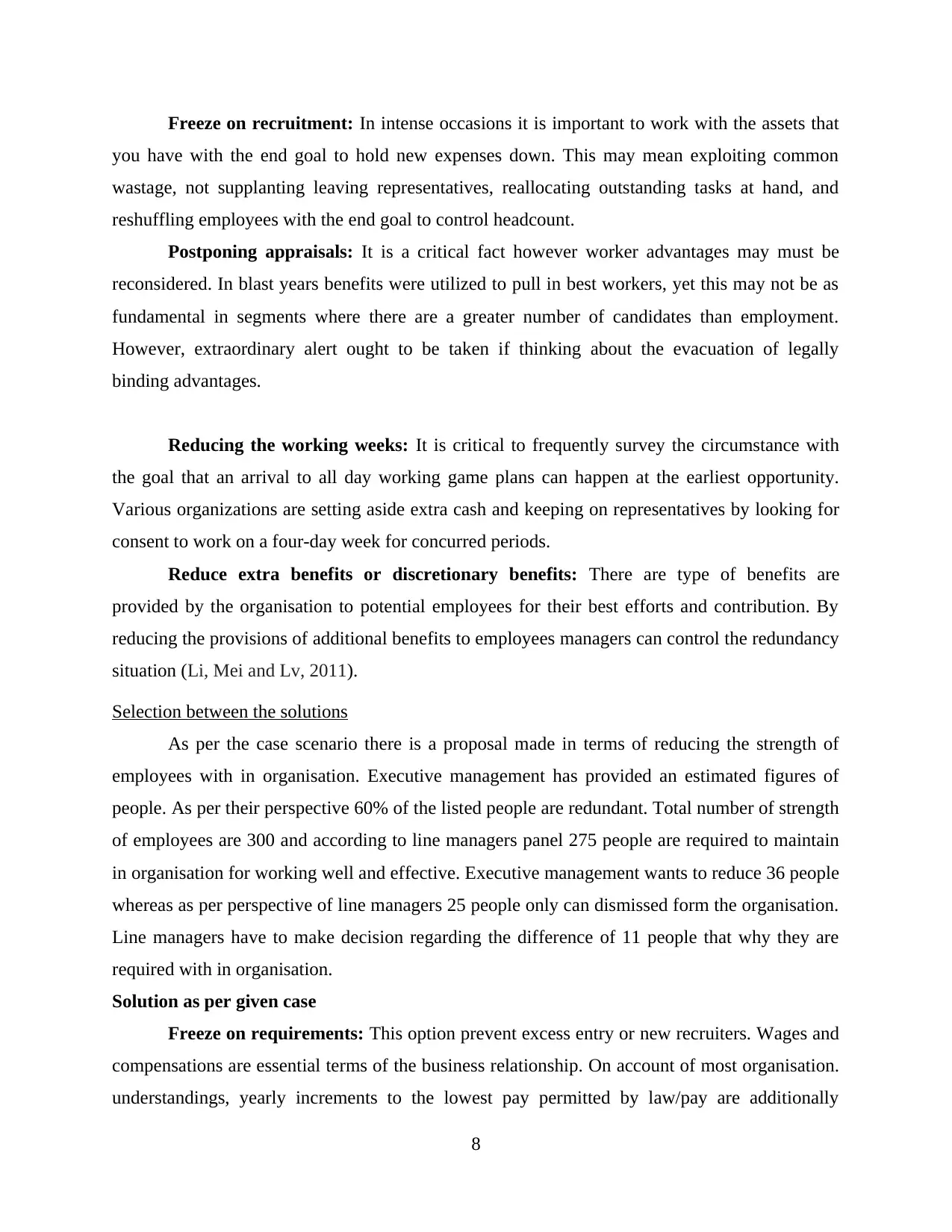
Freeze on recruitment: In intense occasions it is important to work with the assets that
you have with the end goal to hold new expenses down. This may mean exploiting common
wastage, not supplanting leaving representatives, reallocating outstanding tasks at hand, and
reshuffling employees with the end goal to control headcount.
Postponing appraisals: It is a critical fact however worker advantages may must be
reconsidered. In blast years benefits were utilized to pull in best workers, yet this may not be as
fundamental in segments where there are a greater number of candidates than employment.
However, extraordinary alert ought to be taken if thinking about the evacuation of legally
binding advantages.
Reducing the working weeks: It is critical to frequently survey the circumstance with
the goal that an arrival to all day working game plans can happen at the earliest opportunity.
Various organizations are setting aside extra cash and keeping on representatives by looking for
consent to work on a four-day week for concurred periods.
Reduce extra benefits or discretionary benefits: There are type of benefits are
provided by the organisation to potential employees for their best efforts and contribution. By
reducing the provisions of additional benefits to employees managers can control the redundancy
situation (Li, Mei and Lv, 2011).
Selection between the solutions
As per the case scenario there is a proposal made in terms of reducing the strength of
employees with in organisation. Executive management has provided an estimated figures of
people. As per their perspective 60% of the listed people are redundant. Total number of strength
of employees are 300 and according to line managers panel 275 people are required to maintain
in organisation for working well and effective. Executive management wants to reduce 36 people
whereas as per perspective of line managers 25 people only can dismissed form the organisation.
Line managers have to make decision regarding the difference of 11 people that why they are
required with in organisation.
Solution as per given case
Freeze on requirements: This option prevent excess entry or new recruiters. Wages and
compensations are essential terms of the business relationship. On account of most organisation.
understandings, yearly increments to the lowest pay permitted by law/pay are additionally
8
you have with the end goal to hold new expenses down. This may mean exploiting common
wastage, not supplanting leaving representatives, reallocating outstanding tasks at hand, and
reshuffling employees with the end goal to control headcount.
Postponing appraisals: It is a critical fact however worker advantages may must be
reconsidered. In blast years benefits were utilized to pull in best workers, yet this may not be as
fundamental in segments where there are a greater number of candidates than employment.
However, extraordinary alert ought to be taken if thinking about the evacuation of legally
binding advantages.
Reducing the working weeks: It is critical to frequently survey the circumstance with
the goal that an arrival to all day working game plans can happen at the earliest opportunity.
Various organizations are setting aside extra cash and keeping on representatives by looking for
consent to work on a four-day week for concurred periods.
Reduce extra benefits or discretionary benefits: There are type of benefits are
provided by the organisation to potential employees for their best efforts and contribution. By
reducing the provisions of additional benefits to employees managers can control the redundancy
situation (Li, Mei and Lv, 2011).
Selection between the solutions
As per the case scenario there is a proposal made in terms of reducing the strength of
employees with in organisation. Executive management has provided an estimated figures of
people. As per their perspective 60% of the listed people are redundant. Total number of strength
of employees are 300 and according to line managers panel 275 people are required to maintain
in organisation for working well and effective. Executive management wants to reduce 36 people
whereas as per perspective of line managers 25 people only can dismissed form the organisation.
Line managers have to make decision regarding the difference of 11 people that why they are
required with in organisation.
Solution as per given case
Freeze on requirements: This option prevent excess entry or new recruiters. Wages and
compensations are essential terms of the business relationship. On account of most organisation.
understandings, yearly increments to the lowest pay permitted by law/pay are additionally
8
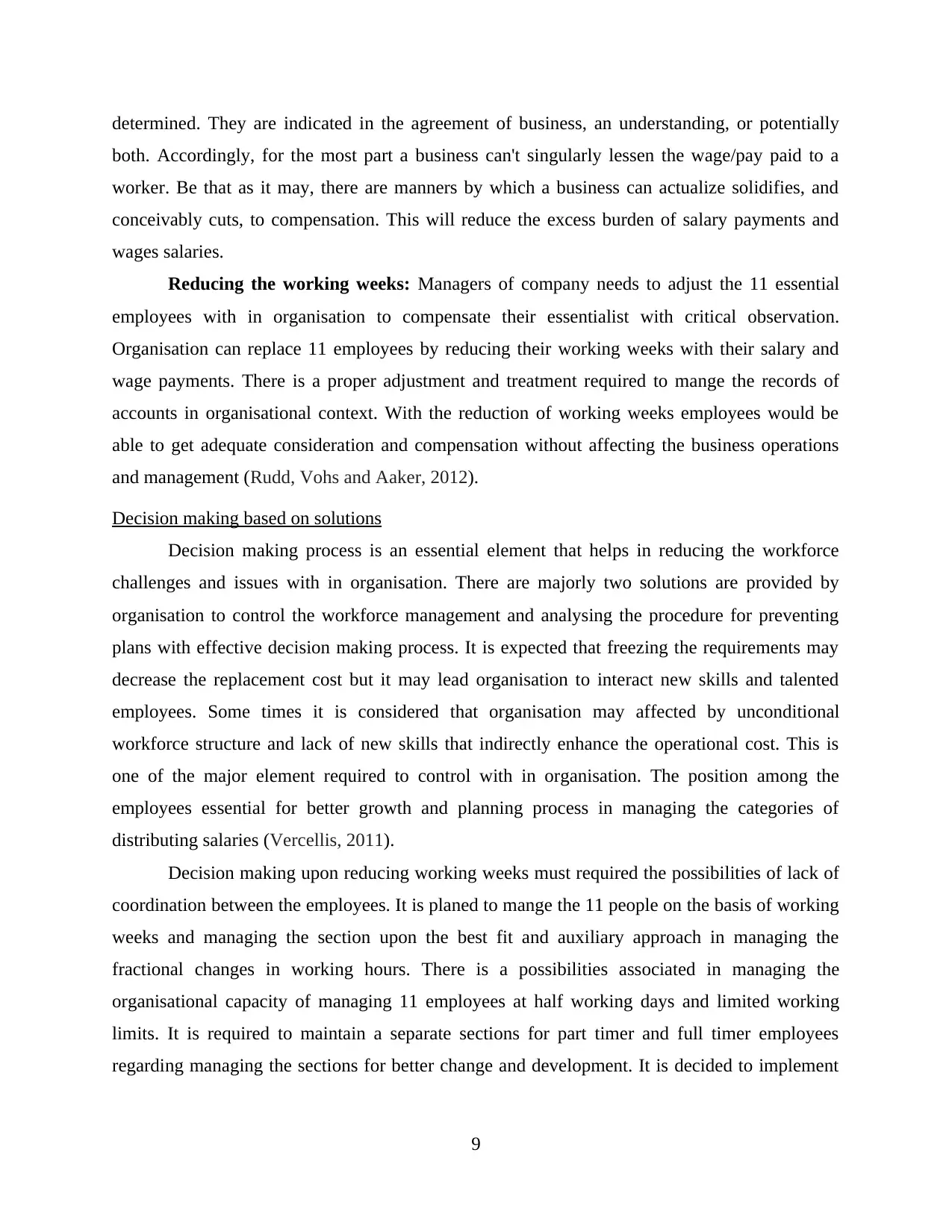
determined. They are indicated in the agreement of business, an understanding, or potentially
both. Accordingly, for the most part a business can't singularly lessen the wage/pay paid to a
worker. Be that as it may, there are manners by which a business can actualize solidifies, and
conceivably cuts, to compensation. This will reduce the excess burden of salary payments and
wages salaries.
Reducing the working weeks: Managers of company needs to adjust the 11 essential
employees with in organisation to compensate their essentialist with critical observation.
Organisation can replace 11 employees by reducing their working weeks with their salary and
wage payments. There is a proper adjustment and treatment required to mange the records of
accounts in organisational context. With the reduction of working weeks employees would be
able to get adequate consideration and compensation without affecting the business operations
and management (Rudd, Vohs and Aaker, 2012).
Decision making based on solutions
Decision making process is an essential element that helps in reducing the workforce
challenges and issues with in organisation. There are majorly two solutions are provided by
organisation to control the workforce management and analysing the procedure for preventing
plans with effective decision making process. It is expected that freezing the requirements may
decrease the replacement cost but it may lead organisation to interact new skills and talented
employees. Some times it is considered that organisation may affected by unconditional
workforce structure and lack of new skills that indirectly enhance the operational cost. This is
one of the major element required to control with in organisation. The position among the
employees essential for better growth and planning process in managing the categories of
distributing salaries (Vercellis, 2011).
Decision making upon reducing working weeks must required the possibilities of lack of
coordination between the employees. It is planed to mange the 11 people on the basis of working
weeks and managing the section upon the best fit and auxiliary approach in managing the
fractional changes in working hours. There is a possibilities associated in managing the
organisational capacity of managing 11 employees at half working days and limited working
limits. It is required to maintain a separate sections for part timer and full timer employees
regarding managing the sections for better change and development. It is decided to implement
9
both. Accordingly, for the most part a business can't singularly lessen the wage/pay paid to a
worker. Be that as it may, there are manners by which a business can actualize solidifies, and
conceivably cuts, to compensation. This will reduce the excess burden of salary payments and
wages salaries.
Reducing the working weeks: Managers of company needs to adjust the 11 essential
employees with in organisation to compensate their essentialist with critical observation.
Organisation can replace 11 employees by reducing their working weeks with their salary and
wage payments. There is a proper adjustment and treatment required to mange the records of
accounts in organisational context. With the reduction of working weeks employees would be
able to get adequate consideration and compensation without affecting the business operations
and management (Rudd, Vohs and Aaker, 2012).
Decision making based on solutions
Decision making process is an essential element that helps in reducing the workforce
challenges and issues with in organisation. There are majorly two solutions are provided by
organisation to control the workforce management and analysing the procedure for preventing
plans with effective decision making process. It is expected that freezing the requirements may
decrease the replacement cost but it may lead organisation to interact new skills and talented
employees. Some times it is considered that organisation may affected by unconditional
workforce structure and lack of new skills that indirectly enhance the operational cost. This is
one of the major element required to control with in organisation. The position among the
employees essential for better growth and planning process in managing the categories of
distributing salaries (Vercellis, 2011).
Decision making upon reducing working weeks must required the possibilities of lack of
coordination between the employees. It is planed to mange the 11 people on the basis of working
weeks and managing the section upon the best fit and auxiliary approach in managing the
fractional changes in working hours. There is a possibilities associated in managing the
organisational capacity of managing 11 employees at half working days and limited working
limits. It is required to maintain a separate sections for part timer and full timer employees
regarding managing the sections for better change and development. It is decided to implement
9
⊘ This is a preview!⊘
Do you want full access?
Subscribe today to unlock all pages.

Trusted by 1+ million students worldwide
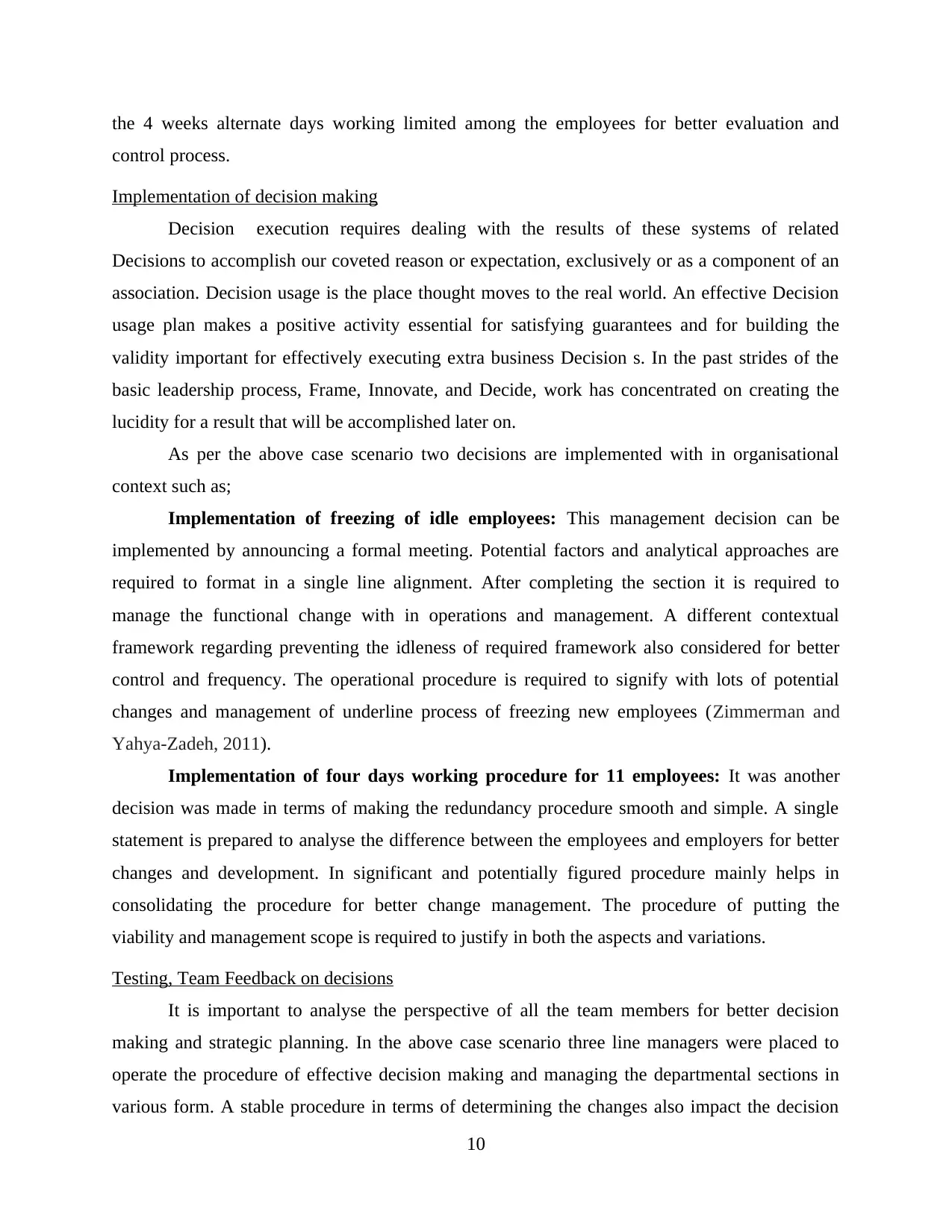
the 4 weeks alternate days working limited among the employees for better evaluation and
control process.
Implementation of decision making
Decision execution requires dealing with the results of these systems of related
Decisions to accomplish our coveted reason or expectation, exclusively or as a component of an
association. Decision usage is the place thought moves to the real world. An effective Decision
usage plan makes a positive activity essential for satisfying guarantees and for building the
validity important for effectively executing extra business Decision s. In the past strides of the
basic leadership process, Frame, Innovate, and Decide, work has concentrated on creating the
lucidity for a result that will be accomplished later on.
As per the above case scenario two decisions are implemented with in organisational
context such as;
Implementation of freezing of idle employees: This management decision can be
implemented by announcing a formal meeting. Potential factors and analytical approaches are
required to format in a single line alignment. After completing the section it is required to
manage the functional change with in operations and management. A different contextual
framework regarding preventing the idleness of required framework also considered for better
control and frequency. The operational procedure is required to signify with lots of potential
changes and management of underline process of freezing new employees (Zimmerman and
Yahya-Zadeh, 2011).
Implementation of four days working procedure for 11 employees: It was another
decision was made in terms of making the redundancy procedure smooth and simple. A single
statement is prepared to analyse the difference between the employees and employers for better
changes and development. In significant and potentially figured procedure mainly helps in
consolidating the procedure for better change management. The procedure of putting the
viability and management scope is required to justify in both the aspects and variations.
Testing, Team Feedback on decisions
It is important to analyse the perspective of all the team members for better decision
making and strategic planning. In the above case scenario three line managers were placed to
operate the procedure of effective decision making and managing the departmental sections in
various form. A stable procedure in terms of determining the changes also impact the decision
10
control process.
Implementation of decision making
Decision execution requires dealing with the results of these systems of related
Decisions to accomplish our coveted reason or expectation, exclusively or as a component of an
association. Decision usage is the place thought moves to the real world. An effective Decision
usage plan makes a positive activity essential for satisfying guarantees and for building the
validity important for effectively executing extra business Decision s. In the past strides of the
basic leadership process, Frame, Innovate, and Decide, work has concentrated on creating the
lucidity for a result that will be accomplished later on.
As per the above case scenario two decisions are implemented with in organisational
context such as;
Implementation of freezing of idle employees: This management decision can be
implemented by announcing a formal meeting. Potential factors and analytical approaches are
required to format in a single line alignment. After completing the section it is required to
manage the functional change with in operations and management. A different contextual
framework regarding preventing the idleness of required framework also considered for better
control and frequency. The operational procedure is required to signify with lots of potential
changes and management of underline process of freezing new employees (Zimmerman and
Yahya-Zadeh, 2011).
Implementation of four days working procedure for 11 employees: It was another
decision was made in terms of making the redundancy procedure smooth and simple. A single
statement is prepared to analyse the difference between the employees and employers for better
changes and development. In significant and potentially figured procedure mainly helps in
consolidating the procedure for better change management. The procedure of putting the
viability and management scope is required to justify in both the aspects and variations.
Testing, Team Feedback on decisions
It is important to analyse the perspective of all the team members for better decision
making and strategic planning. In the above case scenario three line managers were placed to
operate the procedure of effective decision making and managing the departmental sections in
various form. A stable procedure in terms of determining the changes also impact the decision
10
Paraphrase This Document
Need a fresh take? Get an instant paraphrase of this document with our AI Paraphraser

making. It is tested that the executive manager has presented different figures which is reducing
the workforce strength by 60% among the list of sixty people. As per the executive manger's
perspective 36 people are expected to decrease for maintaining the operations well. However,
line managers have evaluated that 25 people can only fluctuated or dismiss for better execution
and operational process. This is one of the challenging factor that is creating the conflicts among
the managers and employees for better change and development.
Feedback on decision
After evaluating the decisions given regarding redundancy it is concluded that various
type of challenges to be faced by managers of organisation. It is required to determine the
challenges with proper management and requirements of section. There is a proper execution
procedures need to follow. Management committee need to submit a valid reason regarding
suitable changes and variation. Retrenchment process also required to follow which seems
missing in the above decision. It is obvious that existing employees will protest these decisions.
It is required to communicate with effective solutions and variations for better execution process.
It is proposed to reduce the working weeks for specific work force. This decision may create
conflicts for consistent workforce for deriving the changes with in appropriate organisational
structure. Managers are required to consolidate the list of functional changes and outcomes after
implementing these strategies.
RECOMMENDATIONS
From the above analysis of the case situation it has been found that this business
organisation is facing issues of low profitability due to loss of their two products from their
product line. In order to revolve this issue company is planning use the approach of redundancy.
As a panel member, it is recommended that executive management of this company should re
consider their decision and should not deploy 36 employees as it will effect their productivity
and can also lead towards work chaos and ineffective management. In order to support this
suggestion of only deploying 25 employees, various recommendations are further added.
Company should use strategy of freezing recruitments in which they should not recruit any
further employees from which there problem can be resolved to a limited extend. In addition, this
company should decrease their working weeks and employ those remaining 11 employees in
these weeks so that all employees will be appointed and company does not have to pay any extra
amount as salary.
11
the workforce strength by 60% among the list of sixty people. As per the executive manger's
perspective 36 people are expected to decrease for maintaining the operations well. However,
line managers have evaluated that 25 people can only fluctuated or dismiss for better execution
and operational process. This is one of the challenging factor that is creating the conflicts among
the managers and employees for better change and development.
Feedback on decision
After evaluating the decisions given regarding redundancy it is concluded that various
type of challenges to be faced by managers of organisation. It is required to determine the
challenges with proper management and requirements of section. There is a proper execution
procedures need to follow. Management committee need to submit a valid reason regarding
suitable changes and variation. Retrenchment process also required to follow which seems
missing in the above decision. It is obvious that existing employees will protest these decisions.
It is required to communicate with effective solutions and variations for better execution process.
It is proposed to reduce the working weeks for specific work force. This decision may create
conflicts for consistent workforce for deriving the changes with in appropriate organisational
structure. Managers are required to consolidate the list of functional changes and outcomes after
implementing these strategies.
RECOMMENDATIONS
From the above analysis of the case situation it has been found that this business
organisation is facing issues of low profitability due to loss of their two products from their
product line. In order to revolve this issue company is planning use the approach of redundancy.
As a panel member, it is recommended that executive management of this company should re
consider their decision and should not deploy 36 employees as it will effect their productivity
and can also lead towards work chaos and ineffective management. In order to support this
suggestion of only deploying 25 employees, various recommendations are further added.
Company should use strategy of freezing recruitments in which they should not recruit any
further employees from which there problem can be resolved to a limited extend. In addition, this
company should decrease their working weeks and employ those remaining 11 employees in
these weeks so that all employees will be appointed and company does not have to pay any extra
amount as salary.
11
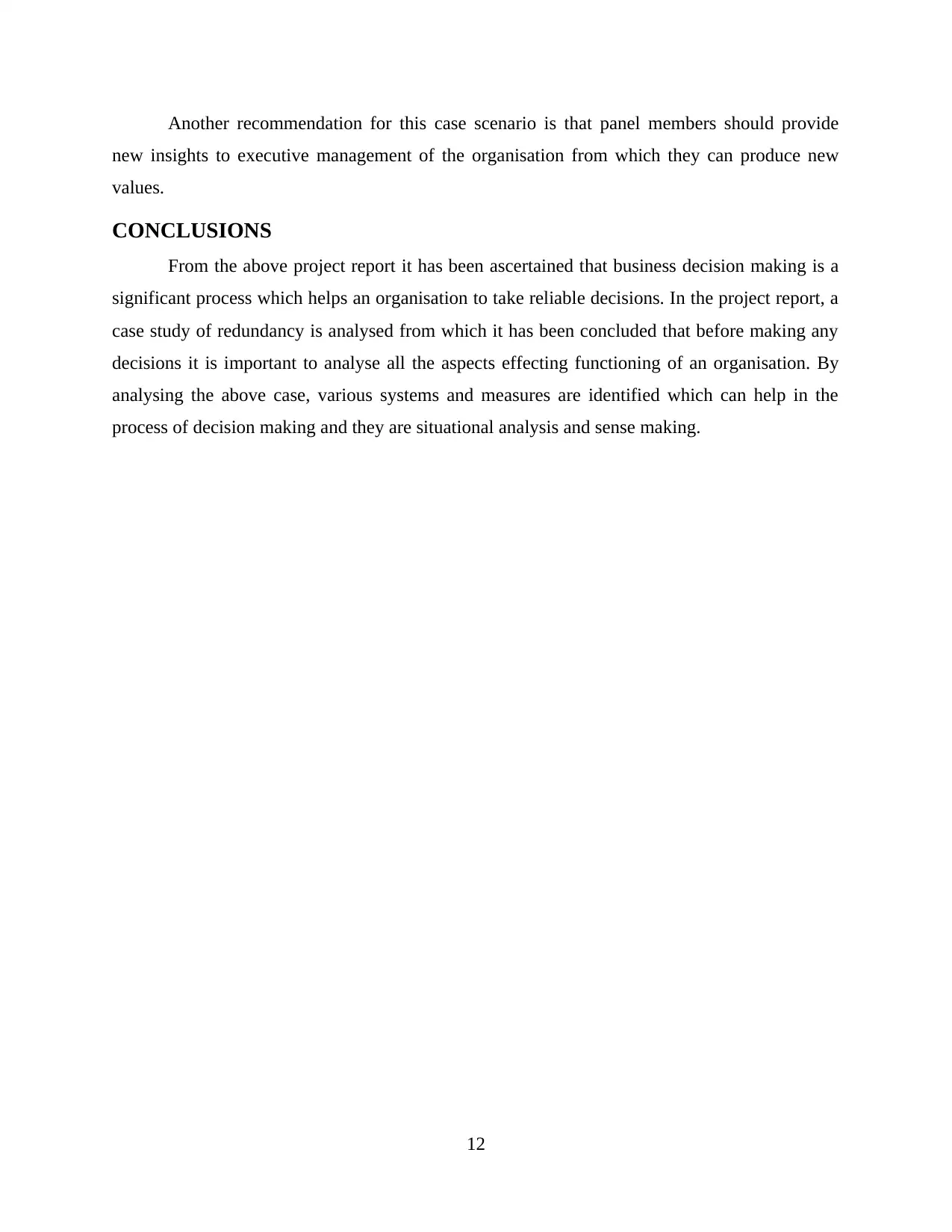
Another recommendation for this case scenario is that panel members should provide
new insights to executive management of the organisation from which they can produce new
values.
CONCLUSIONS
From the above project report it has been ascertained that business decision making is a
significant process which helps an organisation to take reliable decisions. In the project report, a
case study of redundancy is analysed from which it has been concluded that before making any
decisions it is important to analyse all the aspects effecting functioning of an organisation. By
analysing the above case, various systems and measures are identified which can help in the
process of decision making and they are situational analysis and sense making.
12
new insights to executive management of the organisation from which they can produce new
values.
CONCLUSIONS
From the above project report it has been ascertained that business decision making is a
significant process which helps an organisation to take reliable decisions. In the project report, a
case study of redundancy is analysed from which it has been concluded that before making any
decisions it is important to analyse all the aspects effecting functioning of an organisation. By
analysing the above case, various systems and measures are identified which can help in the
process of decision making and they are situational analysis and sense making.
12
⊘ This is a preview!⊘
Do you want full access?
Subscribe today to unlock all pages.

Trusted by 1+ million students worldwide
1 out of 13
Related Documents
Your All-in-One AI-Powered Toolkit for Academic Success.
+13062052269
info@desklib.com
Available 24*7 on WhatsApp / Email
![[object Object]](/_next/static/media/star-bottom.7253800d.svg)
Unlock your academic potential
Copyright © 2020–2025 A2Z Services. All Rights Reserved. Developed and managed by ZUCOL.



